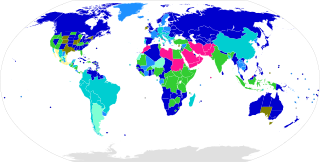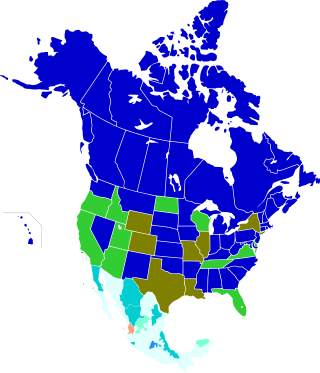
The age of consent is the age at which a person is considered to be legally competent to consent to sexual acts. Consequently, an adult who engages in sexual activity with a person younger than the age of consent is unable to legally claim that the sexual activity was consensual, and such sexual activity may be considered child sexual abuse or statutory rape. The person below the minimum age is considered the victim, and their sex partner the offender, although some jurisdictions provide exceptions through "Romeo and Juliet laws" if one or both participants are underage, and are close in age.

A spouse is a significant other in a marriage. In certain contexts, it can also apply to a civil union or common-law marriage. Although a spouse is a form of significant other, the latter term also includes non-marital partners who play a social role similar to that of a spouse, but do not have rights and duties reserved by law to a spouse.

In criminal law, kidnapping is the unlawful confinement of a person against their will, often including transportation/asportation. The asportation and abduction element is typically but not necessarily conducted by means of force or fear: the perpetrator may use a weapon to force the victim into a vehicle, but it is still kidnapping if the victim is enticed to enter the vehicle willingly.
Marriageable age is the general age, as a legal age or as the minimum age subject to parental, religious or other forms of social approval, at which a person is legitimately allowed for marriage. Age and other prerequisites to marriage vary between jurisdictions, but in the vast majority of jurisdictions, the marriage age as a right is set at the age of majority. Nevertheless, most jurisdictions allow marriage at a younger age with parental or judicial approval, and some also allow adolescents to marry if the female is pregnant. The age of marriage is most commonly 18 years old, but there are variations, some higher and some lower. The marriageable age should not be confused with the age of majority or the age of consent, though they may be the same in many places.
Age of consent is the minimum age at which a person is considered to be legally competent to consent to sexual acts.
The legal age of consent for sexual activity varies by jurisdiction across Asia. The specific activity engaged in or the gender of participants can also be relevant factors. Below is a discussion of the various laws dealing with this subject. The highlighted age refers to an age at or above which an individual can engage in unfettered sexual relations with another who is also at or above that age. Other variables, such as homosexual relations or close in age exceptions, may exist, and are noted when relevant, for example in Indonesia. Also, as noted in the Japanese section, several national laws and each local government ordinance may have different age rules for sexual activity, so sexual activity may be punishable even beyond the ages highlighted below.
The ages of consent vary by jurisdiction across Europe. The ages of consent are between 14 and 18. The vast majority of countries set their ages in the range of 14 to 16; only four countries, Cyprus (17), Ireland (17), Turkey (18) and Vatican City (18), do not fit into this pattern. The laws can also stipulate which specific activities are permitted or specify the age at which one or other sex can legally participate. The highlighted age is that from which a young person can lawfully engage in a non-commercial sexual act with an older person, regardless of their age difference, provided the older one is not in a position of power, a relative, or is committing another form of exploitation. In some jurisdictions, including Italy and Hungary, there are exemptions if the age difference is within prescribed bounds. All jurisdictions in Europe have equal and gender-neutral age limits.

In North America, the legal age of consent relating to sexual activity varies by jurisdiction.

The age of consent in Africa for sexual activity varies by jurisdiction across the continent. The specific activity engaged in or the gender of its participants can also affect this age and the legality of sexual activity. The highlighted age refers to an age at or above which an individual can engage in unfettered sexual relations with another person who is also at or above that age. Other variables, for example homosexual and/or sodomy provision(s) that are illegal or close in age exceptions may exist and are stated when relevant.

Confirmation, in the Catholic Church, is one of the seven sacraments. It is also one of the three sacraments of initiation into the Catholic Church, the other two being Baptism and Holy Communion.
Age of consent reform is an effort to change age of consent laws. Proposed reforms typically include raising, lowering, or abolishing the age of consent, applying close-in-age exemptions, changing penalties, or changing how cases are examined in court. A related issue is whether or not to enforce ages of consent on homosexual relationships that are different from those enforced on heterosexual relationships. Organized efforts have ranged from academic discussions to political petitions.

The age of consent for sexual activity refers to an age at or above which an individual can engage in unfettered sexual relations with another who is of the same age or older. This age varies by jurisdiction across South America, codified in laws which may also stipulate the specific activities that are permitted or the gender of participants for different ages. Other variables may exist, such as close-in-age exemptions.

Teenage marriage is the union of two adolescents, ranging from ages 13 to 19. Many factors contribute to teenage marriage such as love, teenage pregnancy, religion, security, wealth, family, peer pressure, arranged marriage, economical and/or political reasons, social advancement, and cultural reasons. Studies have shown that teenage married couples are often less advantageous, may come from broken homes, may have little education, and work low status jobs in comparison with those that marry after adolescence.

A sodomy law is a law that defines certain sexual acts as crimes. The precise sexual acts meant by the term sodomy are rarely spelled out in the law, but are typically understood by courts to include any sexual act deemed to be "unnatural" or "immoral". Sodomy typically includes anal sex, oral sex, and bestiality. In practice, sodomy laws have rarely been enforced against heterosexual couples, and have mostly been used to target homosexual couples.

In the United States, each state and territory sets the age of consent either by statute or the common law applies, and there are several federal statutes related to protecting minors from sexual predators. Depending on the jurisdiction, the legal age of consent is between 16 and 18. In some places, civil and criminal laws within the same state conflict with each other.
Sexting is sending, receiving, or forwarding sexually explicit messages, photographs, or videos, primarily between mobile phones. It may also include the use of a computer or any digital device. The term was first popularized early in the 21st century and is a portmanteau of sex and texting, where the latter is meant in the wide sense of sending a text possibly with images. Sexting is not an isolated phenomenon but one of many different types of sexual interaction in digital contexts that is related to sexual arousal.
Legal age or codified age refers to age at which a person may legally engage in a certain activity. Most frequently, this is the age of majority, the threshold of adulthood as recognized in law.

The marriage age in the United States is the minimum age at which a person can marry in the United States as a right, or with parental consent or other authorization. This age is set by each state and territory, either by statute or where the common law applies. The general marriage age is 18 years of age in all states except Nebraska, where the general marriage age is 19, and Mississippi, where the general marriage age is 21. The general marriage age is commonly the age of majority, though in Alabama the general marriage age is 18 while the age of majority is 19.
In the United States, the legality of incest varies widely between jurisdictions regarding both the definition of the offense and penalties for its commission.
Sexual consent plays an important role in laws regarding rape, sexual assault and other forms of sexual violence. In a court of law, whether or not the alleged victim had freely given consent, and whether or not they were deemed to be capable of giving consent, can determine whether the alleged perpetrator is guilty of rape, sexual assault or some other form of sexual misconduct.











